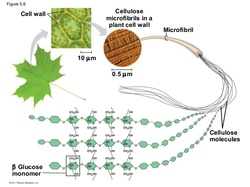Cellulose - the tough part about eating grass! |
|
As we all know, horses are herbivores, evolved to eat predominantly grasses and other fibrous plants. These days the domestic horse has a few more options (not all of them good!), but the digestive system remains the same, and it’s worthwhile having a little understand of exactly how the horse manages to make a living eating grass.
|
The main problem with surviving on grass is its high proportion of structural carbohydrates. For simplicity, I will focus on cellulose, the most abundant in the horse’s diet. Cellulose gives structure to plant cell walls and is insoluble in water – wood is almost completely made of cellulose which gives you an idea of its strength! It is a very large molecule, made up of over 10,000 linked glucose units.
Sounds like a great energy source with all that glucose? Unfortunately the way the glucose units are linked, with a β1-4 bond (unlike other carbohydrates like starch, which have an α1-4 linkage) cannot be broken down by mammalian enzymes, which is why humans can’t digest and metabolise grass. Horses are mammals too – but they, and other herbivores, have developed a neat work around for this problem.
|
Horses have a symbiotic relationship with micro-organisms that live in the gut – these bacteria do produce the enzymes necessary to break cellulose into individual glucose units. But the horse does not get to absorb this glucose – the bacteria consume it, and then produce volatile fatty acids (VFAs) – acetate, propionate and butyrate. The horse absorbs VFAs through the large intestine, and then converts them to glucose or ATP (the energy “currency” of cells) to fuel cellular activity.
|
As an added bonus, the gut bacteria also produce small amounts of essential amino acids and the water soluble B group vitamins and vitamin K2 – meaning the horse does not usually require supplementation of these vitamins, which is lucky because vitamin B12 is not found in any plant sources!
Absorbing enough VFAs to fuel the body, and sufficient amino acids and vitamins that the gut bacteria produce relies on maintaining a healthy population of microbes in the gut. The microbial population changes according to what the horse eats – as different types of bacteria prefer different food. Feeding large amounts of non-structural carbohydrates (e.g. starch) changes the population such that they may not be able to efficiently digest the cellulose that is still coming in (because there is not enough cellulose-loving bacteria), and the horse will not be able to reap the benefits. |
Changes in the bacterial population can result in more bacteria that produce lactic acid, which can lower the pH of the large intestine (make it more acidic). Acidosis may result in gastrointestinal discomfort and potential tissue injury (e.g. ulcers), but pH also has an effect on the bacterial population itself, and optimum absorption of nutrients such as VFAs. The optimal pH for cellulose degrading microbial activity and absorption of VFAs through the intestinal wall is 6.5. Biological systems are so finely tuned that slight deviations from this may reduce the amount of VFAs the horse is able to access, reducing in turn the energy that can be made from it. Not only this, but when VFAs are absorbed into the blood stream through the intestinal wall, some NaCl (salt) goes with it, which then influences the amount of water that is absorbed from the gut!
|
What does all this mean? It is important to not only feed our horses, but also think about feeding the microbes in their guts! Healthy, appropriate microbial population and gut environment mean our horses get the most out of their forage sources – energy, amino acids, and vitamins and can even influence water absorption! This reduces the need for supplementary feeding and avoids the problems that can go with that – a win-win situation!
Find more articles here, and check out the Facebook page for more interesting, informative links and articles from Integral Equine Nutrition. |



